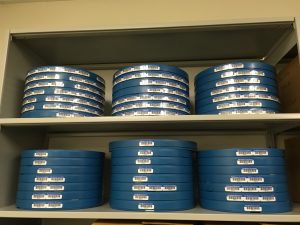Blog
Senator Stevens and the Locked-Up Suffragists
On August 18, 1920 the Nineteenth Amendment to the United States Constitution was ratified. This amendment prohibits state and federal governments from denying the right to vote based on sex, therefore granting women the right to vote. Although at the time the main beneficiaries of the amendment were white women, in modern times the law has since come to cover all women of the nation.
What some of you may not know, is how Senator Ted Stevens ties into the story of the 19th Amendment- clearly he didn’t help pass it so how is he connected? To be fair- his involvement is actually with the Suffragists who helped create the amendment and less with the legislation itself, but he very much wanted to keep the women leaders’ legacies alive and well in the Capitol.
The story all begins back in 1921 when artist Adelaide Johnson, commissioned by the National Women’s Party, delivered her statue Portrait Monument to Lucretia Mott, Elizabeth Cady Stanton, and Susan B. Anthony to the U.S. Capitol for its unveiling ceremony. Unfortunately, the statue only stayed on display for a single day before Congress had it moved down to the basement- otherwise known as “the Crypt”.
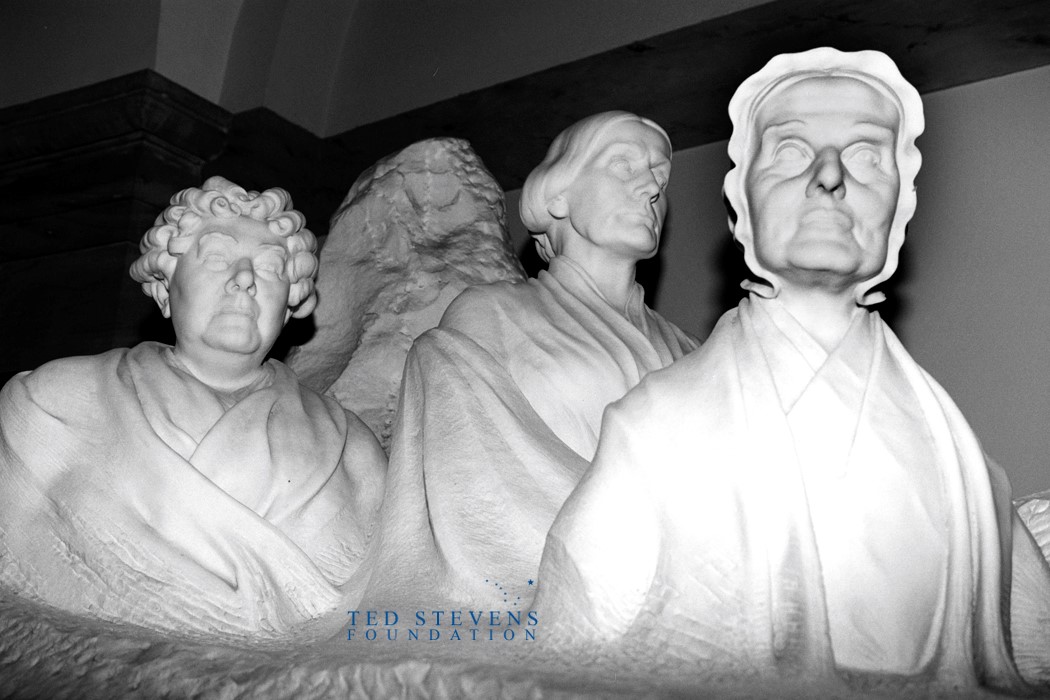
L-r, Elizabeth Cady Stanton, Susan B. Anthony, and Lucretia Mott, depicted in the Portrait Monument, dedicated to pioneers of the suffrage movement, in its original place in the Crypt of the Capitol building photographed on July 17, 1995.
Stevens Foundation photo
It remained hidden there until 1963, when the Crypt was cleaned up and opened to the public, allowing the public to see the Suffragists for the first time in decades. But women were not content to leave the marble statue languishing in the basement.
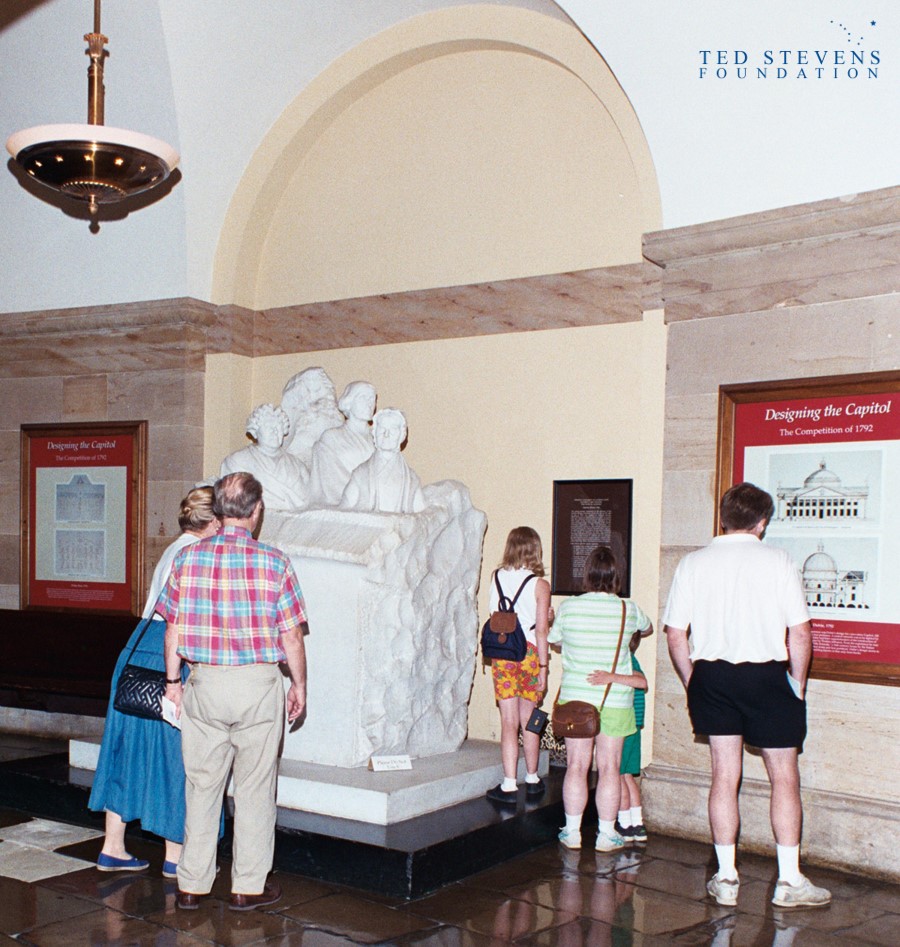
The Portrait Monument, dedicated to pioneers of the suffrage movement, in its original place in the Crypt of the Capitol building on July 17, 1995.
Stevens Foundation photo
The event that led Senator Stevens to becoming involved was actually the fourth time activists had tried to move the statue. The National Women’s Party (NWP) tried in 1995, for the 75th anniversary celebrations of the 19th Amendment’s passing, to begin again the process of convincing Congress to release the ladies. This time though, they found help.
Karen Staser, later founder of the National Women’s History Museum (NWHM) and wife of Jeff Staser- a member of Senator Stevens’ staff, found herself at the Belmont-Paul Women’s Equality National Monument (then the Sewell-Belmont House) and discovered information about the NWP’s efforts to move the Suffragists statue. She offered to set up a meeting between NWP organizers and Senator Stevens- who was raised by suffragists and “learned the suffrage songs as a child and would sing them at the slightest provocation.” (1)
Senator Stevens was delighted to help out and introduced S.Con. Res. 21 on July 14, 1995 (2) to authorize Congress to move the statue up from the Crypt for display in the Capitol’s Rotunda. It passed the Senate unanimously- however, the House shot it down. They did not want to authorize any public funds for the statue’s move and Speaker Newt Gingrich was especially against the statue.
According to Ann E.W. Stone, NWHM Board Member Emerita, the Speaker “was under the impression that this was a push by liberals for political reasons. I called the Speaker’s office and gave him the history of the statue, pointing out the women in the statue were all Republicans and said, ‘So, you have locked three Republican women in the basement.’” (1)
This caused negotiations to move forward, and eventually H.Con. Res. 216 (3) was agreed to on September 27, 1996. The statue could be moved, but only with private non-tax payer funds. The advocates had already begun raising money in hopes for approval, but now the race was officially on!
Senator Stevens attended fundraiser “Raise the Statue” event in Washington, D.C. on July 25, 1996 and met young activist Arlys Endres there. She was only nine years old but already very active in raising awareness for the cause. She desperately wanted to get the statue out of the basement, and sent at least 2,000 letters soliciting donations for the cause before “she finally stopped counting.” (4)
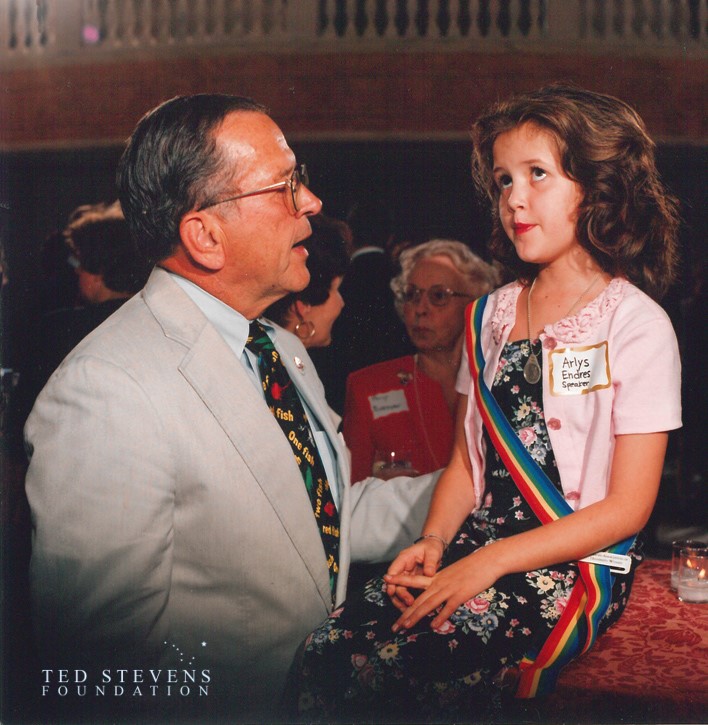
Sen. Ted Stevens greets Arlys Endres, of Phoenix, AZ, a speaker at the “Raise the Statue” event in the Capitol on July 25, 1996. Nine-year-old Endres became passionately involved in raising money to move the statue of suffrage pioneers to a place of honor in the Rotunda, where it stands today.
Stevens Foundation photo.
Arlys and many others managed to raise the “estimated $75,000 required to move” the statue (5) and on May 14, 1997 the monument was officially moved into the Capitol’s Rotunda where it still stands today.
Bibliography & Works Cited:
Architect of the Capitol. “Portrait Monument to Lucretia Mott, Elizabeth Cady Stanton and Susan B. Anthony.” Explore the Capitol Campus / Art. Accessed August 5, 2020. https://www.aoc.gov/explore-capitol-campus/art/portrait-monument-lucretia-mott-elizabeth-cady-stanton-and-susan-b
(5) Boissoneault, Lorraine. “The Suffragist Statue Trapped in a Broom Closet for 75 Years.” Smithsonian Magazine. May 12, 2017. https://www.smithsonianmag.com/history/suffragist-statue-trapped-broom-closet-75-years-180963274/
Deseret News. “Supporters Want to Move Suffragists’ Statue Stuck in Capitol Crypt.” Deseret News. July 3, 1996. https://www.deseret.com/1996/7/3/19252554/online-document-supporters-want-to-move-suffragists-statue-stuck-in-capitol-crypt
(1) National Women’s History Museum. “Moving the Women into the Light: An Interview with NWHM Co-Founder Ann E.W. Stone.” NWHM Article. May 23, 2017. https://www.womenshistory.org/articles/moving-women-light
(2) U.S. Congress. Senate. Directing that the “Portrait Monument”… be restored to its original state and be placed in the Capitol Rotunda. S.Con. Res. 21. 104th Cong., 1st sess. Introduced in Senate July 14, 1995. https://www.congress.gov/104/bills/sconres21/BILLS-104sconres21hds.pdf
(3) U.S. Congress. House. Providing for relocation of the Portrait Monument. H.Con. Res. 216. 104th Cong., 2nd sess. Introduced in House September 24, 1996. https://www.congress.gov/104/bills/hconres216/BILLS-104hconres216ih.pdf
(4) Webb, Dewey. “Desperately Seeking Susan B.” Phoenix New Times. March 13, 1997. https://www.phoenixnewtimes.com/news/desperately-seeking-susan-b-6423335
National Park Service. “Did you know? Suffragist vs Suffragette.” September 20, 2020. https://www.nps.gov/articles/suffragistvssuffragette.htm
Read more50th Anniversary – Live Apollo 11 Moon Landing!
This historical event was part of the Cold War’s Space Race between the United States and the Soviet Union (USSR). The Race had begun back in 1955 when the USSR pledged to launch an artificial satellite following America’s declaration of the same. USSR successfully launched this satellite in 1957 and again beat the US to the first human in space with Yuri Gagarin’s flight in 1961. But America refused to be beaten to the moon.
The Apollo 11 mission was launched on July 16, 1969 and finally touched down on the moon on the evening of July 20, 1969. Two of the three-man crew, Edwin “Buzz” Aldrin Jr. and Neil Armstrong, spent over three hours collecting samples and filming a speech for the people down on earth. The third astronaut, Michael Collins, remained on the command module Columbia that continued orbiting the moon until the lunar module Eagle’s mission was finished.
The lunar module reconnected with the command module, and all three astronauts safely returned to Earth on July 24, 1969 with a landing in the Pacific Ocean.
The landing was filmed and live streamed back to Americans in a record-breaking television event. Alaska was a part of this live stream and, for the first time ever, joined their fellow Americans in viewing a live television event.
Senators Ted Stevens and Mike Gravel, and Representative Howard Pollock, worked together to convince the US Department of Defense (DOD) to relocate a satellite to provide this live TV feed. Prior to this, all television shows in Alaska had been taped elsewhere and then shipped up to the state – there were sometimes gaps of weeks between when ‘live events’ were filmed and then shown on Alaska TV. Alaskans were used to getting the news days later than their Lower 48 compatriots.
But in 1969, thanks to cooperation between our congressional delegation, the DOD, and the National Aeronautics and Space Administration (NASA); Alaskans were able to join in on the action at the exact same time as their fellow Americans.
This historic television event was followed in the Fall of 1969 with a Stevens-sponsored educational satellite TV programming experiment between the state and NASA, which allowed for the potential of these TV feeds to be fully showcased and the technology race officially began in the state.
Read moreTed Stevens and the Alaska Native Claims Settlement Act
The Alaska Native Claims Settlement Act, more commonly known as ANCSA, became law on December 18, 1971. This legislation settled the legal question of Native land claims within Alaska that had been left unaddressed both when the land was purchased by the United States from Russia in 1867, and again under the Alaska Statehood Act in 1958.
The Settlement eventually resulted in the following:
-The creation of twelve Regional Corporations within Alaska and a thirteenth comprised of Natives who are non-permanent residents of Alaska. This idea originated with the Alaska Federation of Natives (AFN).
*The original twelve Corporations were granted land and monetary compensation
*The thirteenth Corporation was granted only monetary compensation
-Native Corporations and approximately 220 Native villages and Regional Corporations were granted title to 44 million acres of land
-Monetary compensation of $462,500,000 paid over an eleven-year period and an additional $500 million in mineral revenues
This legislation was a groundbreaking method for addressing Indigenous land claims and was the first and only of its kind in the United States. It sought to resolve the debate on Native land ownership in Alaska and allowed for the State to finish the land selections it was entitled to under the Alaska Statehood Act.
Senator Stevens was a relatively new member of the US Senate during the debates of ANCSA. He had been sworn in on December 24, 1968 and was immediately thrust into the land claims debate. In a 1991 Tundra Times reflection article, Stevens wrote:
ANCSA was my baptism of fire as a Senator from Alaska…. It didn’t occur to me that some Senators had the opportunity to ease into their jobs. Life in the Senate for me was fast-paced from the beginning…. With my experience working in the Department of the Interior and with the Statehood Act, and my faith in the determination and unity of purpose of Alaska’s Native people, I believed from the beginning that a settlement could be achieved…. My memories of the Congressional action as ANCSA took shape aren’t of a battle as much as they are of long hours of tough, hard negotiating, often two steps forward and one step back… (1)
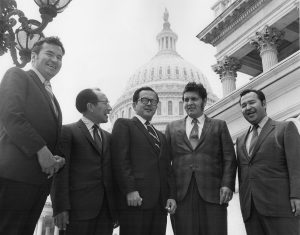
Senator Ted Stevens, center, poses with from L-R, Morris Thompson (BIA), Eben Hopson (AFN), Stevens, John Borbridge (AFN) and Flore Lekanof (D of Interior) on the Capitol steps July 15, 1970, the day S. 1830, the first version of the Alaska Native Land Claims Bill passed in the Senate. (Subsequently, the House did not act on it.) Stevens Foundation photo.
Given his background, Stevens understood the importance of a settlement originating from, and supported by, Alaska’s Native people. To that end, he worked to ensure that Alaska Native leaders, including AFN representatives Don Wright; Emil Notti; Morris Thompson; Mary Jane Fate; Howard Rock; Alice Brown; Marlene Johnson; Brenda Itta; Lille McGarvey; Frances Degnan; and Willie Hensley, had a seat at the table.
Stevens joined countless other Alaskans involved in the governmental debate such as former governor and then-Secretary of the Interior Wally Hickel; then-Governor Bill Egan; Congressman Nick Begich; and Senator Mike Gravel.
The group was also supported by influential Washington Senator Henry “Scoop” Jackson, who ended up sponsoring one of the original ANCSA bills (S. 1830) alongside many other legislators including Stevens and Gravel.
Stevens supported the Settlement proposed by Native leaders, and worked to ensure it solved as many of the long-standing Aboriginal land claim issues as possible. He also supported its aspect of future economic development and self-sufficiency ideals for the Regional Corporations as a means to benefit their shareholders.
ANCSA was a compromise that took years to solidify as law, and amendments have been added numerous times over the past four decades. It is not foolproof, but Alaskans and their legislators have worked hard to address the issues that have arisen over the years and will continue to do so in the future.
For more information, please see:
Hensley, William L. Iggiagruk. Fifty Miles from Tomorrow: a Memoir of Alaska and the Real People. Sarah Crichton Books: 2010.
Jones, Richard S. Alaska Native Claims Settlement Act of 1971 (Public Law 92-203): History and analysis together with subsequent amendments. Report No. 81-127 GOV. 1981-06-01. http://www.alaskool.org/PROJECTS/ANCSA/reports/rsjones1981/ANCSA_History71.htm
Landye, Bennett, Blumstein LLP. ANCSA Resource Center. https://lbblawyers.com/ancsa/
Stevens, Ted F. “ANCSA was my baptism of fire.” Tundra Times. A Scrapbook history: Alaska native claims settlement act. 1991. http://www.alaskool.org/projects/ancsa/ancsa_scrapbook/scr00002.htm (1)
Ted Stevens Foundation. ANCSA and the Agents of Change oral history project. https://tedstevensfoundation.org/ancsa-agents-change/
Read moreStevens Audiovisual Collections
Welcome to the first official blog post of the Ted Stevens Foundation! We’ll be using this space to discuss archival happenings and holdings, Foundation events, and items from Senator Stevens’ history in public service.
Today’s post is on the Audiovisual (AV) holdings within the Collection. Though we usually refer to them as the ‘Ted Stevens Papers Collection’ – they’re actually much more than that. The Stevens Collection consists of:
-
- Over 4,000 boxes of paper documents
- Over 9,000 AV items (also known as our ‘Media Series’)
- Over 2,500 memorabilia objects (these include everything from campaign items to awards to artworks collected by the Senator over his 40 years in office)
- And tens of thousands of photographs (both analog and born-digital formats)
Our Media – AV Series alone holds a variety of formats which all come with their own difficulties and archival processing challenges. A number of our formats are considered ‘obsolescent’ at this time, which means that the format is either no longer produced and/or that the technology or machinery needed to playback the media is also no longer produced or easily available.
This makes the archiving and preservation process even more of a challenge as a lot of the formats are not playable in their current analog form, but it also means that digitizing them is very difficult and cost-prohibitive. Not only can we not be 100% sure of what exactly is on the media as we have to trust the sometimes vague labels and we cannot play it back to verify content, but we are also facing the reality that the older machines used to play and digitize the materials are breaking down and digitizing is becoming more expensive by the day.
Some of the formats contained within our AV collection are:
Many of these formats are practically unknown to today’s younger generations, and many are considered ‘obsolete’ due to the above stated concerns.
You can see some of our film/video formats pictured below: 16 mm film; Betcam SP; 2” Quad Tape; EIAJ-1 Film; Betamax; and U-matic.
And the audio formats shown below are: Vinyl Record; ¼” Audio Reel; Dictabelt; and an Edison Voicewriter Disc.
Also shown is the older version of the floppy disk that measures a whopping 5.25” and is actually ‘floppy’. We also have some of more common later versions – the 3.5” hard plastic (not really that floppy) floppy disk. Though these are not technically ‘audiovisual’ materials – we do store them alongside the AV items as they require similar storage conditions and are not suitable for storage alongside the paper documents.
Our plans for our audiovisual materials are to continue digitizing our rarer content as well as the formats that are becoming more cost-prohibitive and difficult to digitize as time goes on. Our goal is to provide access and usability for our collection upon its opening to the public, and that is especially important when it comes to our AV items as their current formats do not provide ease of access or usability.
Since Stevens was a U.S. Senator for 40 years, we have audiovisual items dating all the way back to the 1960s – and it is especially important to preserve these items for our state’s history and for the Senator’s legacy, as many of the items are unique and not available elsewhere.
You can help us preserve the Senator’s legacy and our collection by donating to the Foundation today.
You can also view some of our digitized audiovisual items online by visiting our video gallery at: https://tedstevensfoundation.org/papers-project/you-tube-gallery/
You can learn more about some of the formats mentioned above at the following webpages from the “Museum of Obsolete Media”:
Dictabelt
Voicewriter Discs
EIAJ-1
